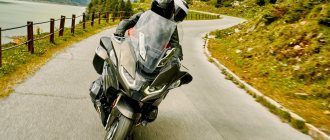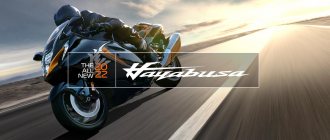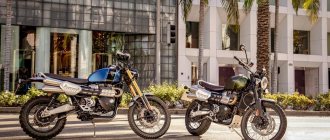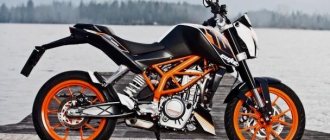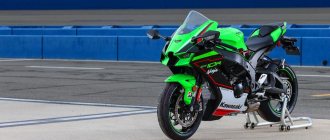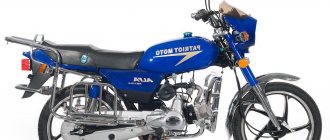Background of the RT line
The BMW R 100 RT, which appeared in 1976, was released as a more relaxed and comfortable version of its sporty cousin, the BMW R 100 RS. The RT is a fully cowled touring motorcycle with a protective fairing based on the R 100 RS, but wider and with a larger vertical windscreen. In 1984, the BMW R 100 RS was discontinued, but the RT continued to be produced as it was much more functional and therefore much more popular.
When the boxer BMW R 1100 finally replaced the classic /7 series in 1996, the BMW R 1100 RT was the flagship of the family. It offered the same comfort and wind protection that made the original R 100 RT a success, but with a more sophisticated aerodynamic shape that combined the designs of the past RT and RS. The RT continued to evolve from then on until the new GS took over the role of the company's flagship, but even then the RT's unrivaled performance and superb on-road capabilities kept it from remaining in the shadows.
BMW R1250RT design
There is absolutely no doubt that the BMW R1250RT has seen a lot of wind tunnels during the development process, this is confirmed by its design.
The low-profile front fender of the BMW R1250RT reveals a sporty-looking touring bike with low drag. The widely spaced stock headlights are equipped with halogen light sources, but to install LED angel eyes you will need to look in the accessories catalog. It's a pity, but the Bavarians periodically move the necessary things that were stock on previous versions to the catalog of additional equipment. True, the opposite also happens, maybe next year it will be the same?
BMW R 1250 RT
The appearance in 2021 of a 136-horsepower 1250 cc four-valve boxer with overhead camshafts has given the RT model even more attractive. And now BMW Motorrad has further improved this wonderful model by equipping it with modern electronic features. The new R 1250 RT is perhaps the most technologically advanced motorcycle in the touring segment, and even more importantly, it is extremely comfortable and easy to use.
Electronic assistants BMW R 1250 RT 2021
The BMW R 1250 RT is equipped with two electronic systems, one of which controls the dynamic functions of the motorcycle, and the second controls its complex engine. Both of them are closely integrated, but still, given their wide functionality, they represent separate systems that work both independently and jointly. The range of dynamic functions is based on Bosch's latest six-axis inertia measurement platform, the most advanced on the market.
A good example is the evolution of the BMW R 1250 RT's ABS braking system. The new fully integrated ABS Pro braking system allows you to activate both brake circuits by pressing the right lever or pedal - no difference. Both 320 front discs with four-piston Hayes calipers and a 276mm rear disc with a floating two-piston caliper will handle braking based on the bike's lean angle, automatically distributing braking force to each wheel and calculating weight transfer based on lever or pedal force. All this allows you to brake as safely and effectively as possible without worrying about the brakes locking.
BMW R 1250 RT
The updated Dynamic Traction Control has been improved to ensure maximum handling of the BMW R 1250 RT in all riding conditions. This feature also includes Hill Start Control and can be integrated with optional Riding Modes Pro, which includes four riding modes including Dynamic. In addition, this includes an engine braking control system (Engine Trag Torque) when closing the throttle. There is also an Eco mode that optimizes fuel consumption.
The new Dynamic Cruise Control is fitted as standard and works not only on the throttle body to control engine speed, but also on the braking system to maintain the selected speed when driving downhill, for example. Active Cruise Control, available as an option, adds the ability to control the speed of the BMW R 1250 RT by monitoring passing vehicles and maintaining a rider-selected distance from the vehicle in front. This is done using a radar sensor, the data from which is sent to the engine ECU. A separate remote control for cruise control is located near the left handlebar, and an icon indicating the selected distance appears on the 10.25-inch TFT instrument panel display. The display also displays settings for security and assistance systems, and in conjunction with a smartphone displays navigation and other wireless functions (such as call and music control). The display is perfectly readable in any lighting conditions, and the phone can be placed in a special compartment with a USB socket and a wireless charging module. In addition, on-board electronics may include an optional audio system and adaptive LED headlights.
Engine BMW R 1250 RT 2021
The new version of the BMW boxer is homologated to Euro 5 thanks to an advanced ECU. The BMW R 1250 RT engine retains 136 hp at 7,750 rpm and 142 Nm of thrust at 6,250 rpm , while the content of harmful substances in the exhaust gases is reduced compared to the previous version. At the same time, the engine has a smooth and uniform torque plateau from 2000 rpm, and 120 Nm is available already at 3500 rpm. The new version of the engine retains the same geometry - a piston diameter of 102.5 mm and a stroke of 76 mm, as well as a compression ratio of 12.5:1. The combustion chamber has an extremely compact profile, and the valves are set at an adjacent angle of 18 degrees: the intakes are set at an angle of 8 and the exhausts are set at an angle of 10 degrees. The valve diameters are 40mm for intake and 34mm for exhaust. Each cylinder is equipped with a separate 52mm throttle body with two injectors.
BMW R 1250 RT
BMW designers continue to refine the legendary boxer engine, equipping it with modern technological features. Thus, variable phases and valve strokes make it possible to control the engine response depending on the speed, and the combustion of the fuel-air mixture is significantly optimized to meet modern environmental standards. This required adjusting the valve stroke by mechanically switching the camshaft cams from medium to high profile, as well as reconfiguring the camshafts to change the duration of the valve overlap phase. The new engine's timing mechanism features pushrods directly driven by the camshaft lobes, and the intake valves feature asynchronous opening timing for a highly turbulent intake that ensures maximum combustion efficiency.
Efficient supply and ignition of the mixture and optimal timing are only half the battle for maximum environmental friendliness of the engine. The other half is an advanced sequential injection system and a volumetric catalytic converter in the exhaust tract, plus digital engine control carried out by the BMS-O ECU. The final touch of efficiency is combined air-liquid cooling, which uses antifreeze to cool the cylinder heads and tops.
BMW R 1250 RT chassis
The chassis structure is centered around a massive engine block, used as the structural strength element, with parts of the frame bolted to it at the front and rear. Fully customizable ESA suspension elements - the Telelever fork and Paralever rear suspension can be optionally equipped with the Dynamic ESA “Next Generation” active electronic suspension system. The motorcycle has a relatively short wheelbase of 148.6 cm, the fork offset angle is 25.9 degrees (however, in the Telelever suspension it changes with wheel travel), and the trail is 11.7 cm. The BMW R 1250 RT is equipped with 17-inch wheels measuring 120/70 at the front and 180/55 at the rear, the standard seat height is 82.5 cm with the ability to set it to a lower position - 80.5 cm. The declared weight of the motorcycle is 279 kg , and the distribution of this mass along the axles is not disclosed.
Design and ergonomics
From the side, the new BMW R 1250 RT appears quite graceful, but when viewed from the front, a massive front fairing is revealed, providing maximum comfort in any weather and at any speed. A wind tunnel was used to optimize the RT's body kit, and the fairing works with the adjustable windshield to redirect turbulence away from the rider. At high speeds, the wind protection of the BMW R 1250 RT provides an incredible level of comfort, almost completely cutting off the oncoming air flow, and when driving in cool weather, the heated grips and seat are very useful.
BMW R 1250 RT
Touring motorcycle BMW R1250RT
Touring motorcycle BMW R1250RT
Although this is a “super” motorcycle, it is still a touring motorcycle. Above the front fairing is a medium-sized electronically adjustable windshield that reduces the pressure of the incoming air flow on the chest, redirecting it higher and allowing the ventilation valves of the helmet to operate. Due to the fact that part of the oncoming flow passes inside the windshield, the effect of shaking the helmet by turbulent eddies at the border of the air pocket, which often happens with “deaf” windshields, is significantly reduced.
The wings of the “muzzle” of the BMW R1250RT with mirrors installed on them deflect the wind from the hands, and next to the mirrors there are transparent turn signals, made flush with the plastic of the fairing, like the headlights.
The instrument panel consists of a pair of dial instruments - a speedometer and a tachometer - with a set of indicators and a uniquely located digital display that displays other details. Above this display is another, 5.7-inch diagonal, color, designed for communication between the rider and the motorcycle - for example, communication with a smartphone and multimedia playback.
The voluminous 25-liter tank of the BMW R1250RT has a rather complex shape: a narrowed part for gripping with the knees, an almost flat top for good aerodynamics and a steep slope to the wide seat.
The seat of a touring motorcycle is adjustable in height and has a fairly comfortable shape: narrow at the front edge and wide closer to the passenger part. The passenger area is also wide, and the rest of the passenger area equipment consists of folding footrests and large rear handles.
Many manufacturers dare to call touring motorcycles that do not have standard panniers, but we, as users, say a resounding “no” to this approach. BMW got us right this time and equipped the RT with a pair of stock hard cases with enough capacity for serious travel. And yes, they are also aerodynamic. The central case is available - yes, yes - in the accessories catalogue. LED lighting crowns the rear of the motorcycle.
BMW R 1250 RT 2021 test
The engine of the BMW R 1250 RT is superb, with powerful, immediate response at any speed, exceptionally torquey at any speed, in the city and on the highway. The balance shaft almost completely absorbs vibration from the opposed cylinders, ensuring smooth operation. In Road mode, the engine has a comfortable, soft response, but in Dynamic mode it impresses with its composure and a clear sense of connection between the throttle and revolutions.
The BMW R 1250 RT steers clearly, accurately and confidently even at very high speeds, corners perfectly and maintains its trajectory. The front wheel feels quite light, but maintains excellent traction with the asphalt, providing easy and intuitive control. On narrow mountain roads with poor asphalt crossed by roots growing underneath, the BMW R 1250 RT does not move so confidently, due to the high center of mass and some imbalance in the suspension.
The BMW R 1250 RT ensures safe driving at night thanks to its powerful LED headlights (even in the basic version). However, the optional adaptive headlights provide excellent cornering illumination without disturbing oncoming drivers.
